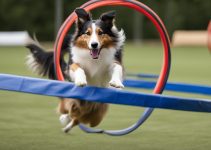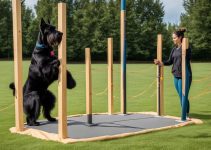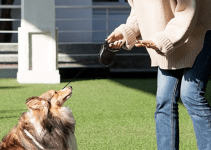Training a dog to walk on leash is an essential skill for every dog owner. It provides an opportunity for exercise, mental stimulation, and bonding between the owner and their furry friend. By utilizing appropriate leash training methods and dedicating time and patience to the process, walking a dog on leash can become an enjoyable experience for both parties involved. This guide will help unveil the secrets to success in achieving a harmonious leash walking experience with your dog.
Training a Dog to Walk on Leash
- Select comfortable and appropriate walking gear for your dog, such as a non-retractable leash, comfortable collar or harness, and ID tags.
- Focus on positive reinforcement techniques, like offering treats and praise, to encourage desired walking behavior.
- Establish a consistent walking routine and gradually introduce new environments and distractions.
- Master basic obedience commands, such as ‘sit’, ‘stay’, and ‘come’, before attempting outdoor leash training.
- Incorporate training techniques like start-and-stop, direction changes, and the ‘heel’ command to maintain focus and discourage pulling.
- Practice patience and remain vigilant about potential hazards and distractions during walks.
- Make safety a top priority by staying mindful of weather conditions and keeping an eye on your dog’s body language.
Understanding the Importance of Leash Training for Dogs
Leash training for dogs is vital for a variety of reasons, ranging from the dog’s safety and physical health to mental stimulation and socialization. By incorporating dog leash training tips into your daily routine, you not only help your dog lead a healthier life, but you also create a more pleasurable and less stressful walking experience for both you and your canine companion.
One of the primary reasons to emphasize the importance of dog walking is the direct impact it has on your dog’s health. Regular walks contribute to weight maintenance, preventing obesity and its related health issues. Additionally, walking helps improve cardiovascular fitness, ensuring a stronger heart and better overall physical condition for your dog.
Mental stimulation is another crucial aspect of leash training. Exposure to new environments, scents, and sounds provides an enriching sensory experience, which in turn helps your dog grow in confidence and adjust to different scenarios. Moreover, walking routines can have a calming effect on dogs, setting positive behavior expectations and helping to address any potential anxiety or stress issues.
Lastly, leash training plays a significant role in socialization. During walks, your dog has the opportunity to interact with other dogs, animals, and humans, enhancing their social skills and making them less fearful or aggressive. When your dog is comfortable and well-behaved on a leash, you can confidently explore new places together, knowing that both of you will enjoy the experience.
Understanding and implementing effective leash training for dogs is indispensable for any responsible dog owner. Not only will it enhance the bond between you and your furry friend, but it will also result in a happier, healthier, and well-rounded pet.
1. Preparing for Your First Leash Walking Session
When it comes to making leash walking an enjoyable experience for both you and your furry friend, it’s crucial to have the right gear and know how to properly introduce it. In this section, we will explore the best solutions for choosing dog leashes and collars, as well as effective ways to introduce your dog to their new walking gear.
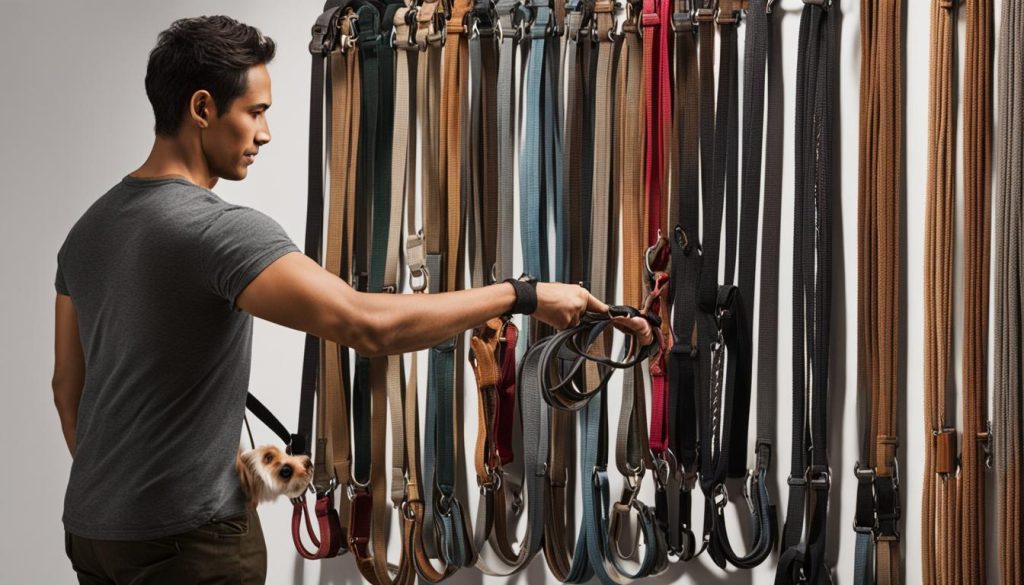
Choosing the Right Leash and Collar
Firstly, selecting suitable equipment is essential for successful leash training. Opt for a comfortable and fitting collar or a no-pull harness to prevent undesired pulling. A no-pull harness can do wonders in helping your dog understand the correct walking behavior without causing them any discomfort. For the leash, choose a sturdy, non-retractable leash around 4-6 feet in length to ensure controlled exploration for your pet.
Dog collars should always have ID tags attached for added safety, in case your pooch runs off or gets lost. Moreover, always keep treats handy to reward your dog during your training sessions, as they serve as a valuable training aid.
Introducing Your Dog to Their Walking Gear
Before bringing out the leash, it’s essential to familiarize your dog with their walking gear to prevent distractions and unease. Start by introducing the collar or no-pull harness to your dog without attaching a leash initially. This will help them get accustomed to the new equipment gradually.
You can also use high-value rewards to encourage your dog to walk at your side, even without a leash. Offering treats consistently at your side, without pulling, will help reinforce the proper walking position and create positive associations with wearing their leash and collar.
With patience, positivity, and the right equipment, you’ll be setting the stage for successful dog leash training and enjoyable walks for years to come.
2. The Fundamentals of Dog Leash Training
Mastering the dog leash training basics is essential for a harmonious walking experience with your canine companion. The foundation of successful leash training lies in basic obedience commands, such as ‘sit’, ‘stay’, and ‘come’. It’s important to begin leash training a puppy as early as possible to reinforce proper walking behaviors from a young age.
Consistency is the key to teaching loose leash walking. Start practicing in a quiet and controlled environment to minimize distractions and help your dog focus. Be sure to reward non-pulling behavior with treats and praise to positively reinforce the desired walking position. You can also gradually introduce more distractions to challenge your dog and simulate real-life walking scenarios.
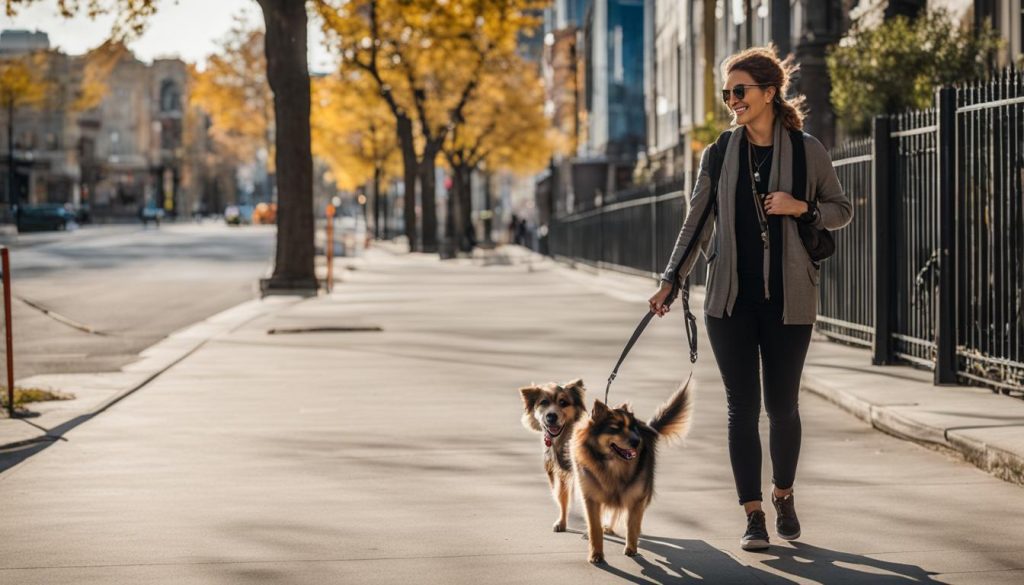
Another important aspect of leash training is learning to read your dog’s body language. By closely observing their cues, you can preempt potential distractions and address any unwanted behaviors before they escalate. This enables you to have a better grasp on your dog’s well-being and to redirect their focus when necessary.
A crucial skill to teach your dog during leash training is the heel command. When properly taught, the heel command can significantly improve your dog’s focus and overall walking experience. Start by consistently rewarding your dog when they walk in the desired position beside you, and gradually increase the distance between rewards as they become more comfortable in that position.
Remember that patience is vital when it comes to leash training. Your dog may not learn these skills overnight, and every dog will progress at their own individual pace. By staying positive and consistent in your training approach, you can create a strong foundation for a well-behaved walking companion.
3. Effective Techniques for Loose Leash Walking Training
There are numerous techniques that can make loose leash walking training more efficient and enjoyable for both you and your dog. The core of effective leash training lies in positive reinforcement dog training and focusing on behavior that discourages pulling. We will explore how to successfully employ rewards-based leash training, teach a dog to walk on leash, and the heel command.
Positive Reinforcement: Rewards and Praise
By using treats, praise, and affection as rewards, you can encourage desired behaviors such as walking calmly beside you. Creating positive associations with good manners makes it more likely that your dog will continue to exhibit these behaviors.
When teaching a dog to walk on a leash, it’s essential to reward them for maintaining a loose leash and not pulling. Offer treats and praise when they walk nicely, always ensuring that you’re reinforcing the right behavior. Remember not to reward your dog when they’re pulling, as this will only reinforce the undesired behavior.
Teaching Heel with Consistency
Training a dog to heel is an essential aspect of walking a dog on a leash with consistency. The heel command instructs your dog to position themselves beside you without pulling. It’s important to keep rewarding your dog as they maintain this position, especially during the early stages of training.
Gradually increase the distance before offering rewards, always making sure to maintain the heel position. Using figure-eight walks and changing your pace can help teach your dog to adapt to your movement and stay in the heel position. Encouraging and rewarding voluntary check-ins from your dog during walks can also greatly improve their focus and responsiveness.
Loose leash walking training can be made more effective through the use of positive reinforcement dog training and consistency. By rewarding your dog for maintaining a loose leash and adhering to the heel command, you can help your furry friend become a well-behaved walking companion.
4. Preventing and Addressing Common Leash Issues
As a dog owner, I’ve dealt with my fair share of leash-related problems. While some challenges are simply part of the learning process, there are ways to prevent and address common leash walking issues, such as pulling and leash aggression.
Preventing leash pulling: One of the primary concerns when walking a dog on a leash is dealing with pulling. To prevent this issue, a no-pull harness can be invaluable in training your dog to walk properly. Teaching your dog leash manners and using techniques like stopping in place, changing direction, and practicing commands that focus on proper leash behavior can help to significantly reduce pulling.
Addressing leash aggression: Another common issue that may arise is leash aggression. To address this concern, it’s essential to identify the triggers and use appropriate counter-conditioning and desensitization techniques. Regular socialization, positive reinforcement, and having constructive redirection strategies, such as treat magnets, can assist in managing and improving leash aggression, making walks more enjoyable for both you and your pet.
Being prepared for unexpected challenges during walks enables you to swiftly divert your dog’s attention and maintain a calm and controlled environment. In turn, this fosters confidence in your dog and improves their ability to navigate various situations. Keep in mind that every dog is unique, and it may take time, patience, and persistence to find the most effective approach to preventing and addressing common leash walking issues.
READ: How to Teach Your Dog to Shake Hands
Conclusion
Training a puppy to walk on leash is a rewarding journey that enhances the bond between dog and owner. By employing proper leash training techniques and maintaining patience, positivity, and consistency, you are paving the way for enjoyable dog walks with a well-behaved companion.
As your dog learns to walk on a leash, it’s essential to celebrate their achievements and adapt to their learning pace. Consistent reinforcement helps keep your dog focused on maintaining good manners during their walks. With time and persistence, you will see the fruit of your efforts in a happy and obedient dog, making each walking session a pleasure for both of you.
Remember, the key to successful leash training lies in understanding your dog’s needs, staying committed to the training process, and practicing regularly. By investing time and effort into your dog’s leash training, you are not only creating a safer environment for them but also improving your dog’s overall well-being and your walking experiences together.
FAQ
What is the importance of leash training for dogs?
Leash training is vital for a dog’s safety, physical health, mental stimulation, and socialization. Regular walks contribute to weight maintenance and cardiovascular fitness, exposure to new environments helps build confidence, and walking routines can calm dogs and set behavior expectations.
How do I prepare for my first leash walking session with my dog?
Select appropriate equipment like a comfortable collar or no-pull harness and a non-retractable leash. Introduce your dog to their walking gear without the leash first, using high-value rewards to encourage walking at your side.
What are the fundamental aspects of dog leash training?
The fundamentals include teaching basic obedience commands like ‘sit’, ‘stay’, and ‘come’. Consistency is key, beginning in quiet areas and rewarding non-pulling behavior, then slowly introducing more distractions while maintaining a positive and rewarding experience.
What are some effective techniques for loose leash walking training?
Techniques include positive reinforcement using treats, praise, and affection, as well as taking abrupt changes in direction to teach the dog that pulling will not lead to their desired location. Consistently rewarding the dog in the heel position is crucial for teaching proper walking on a leash.
How can I prevent and address common leash issues like pulling and aggression?
Prevent pulling with no-pull harnesses and techniques like stopping in place, changing direction, and practicing commands focused on proper leash behavior. For addressing leash aggression, have strategies in place to divert attention and temporarily use treat magnets to build confidence and calmness in various situations.

